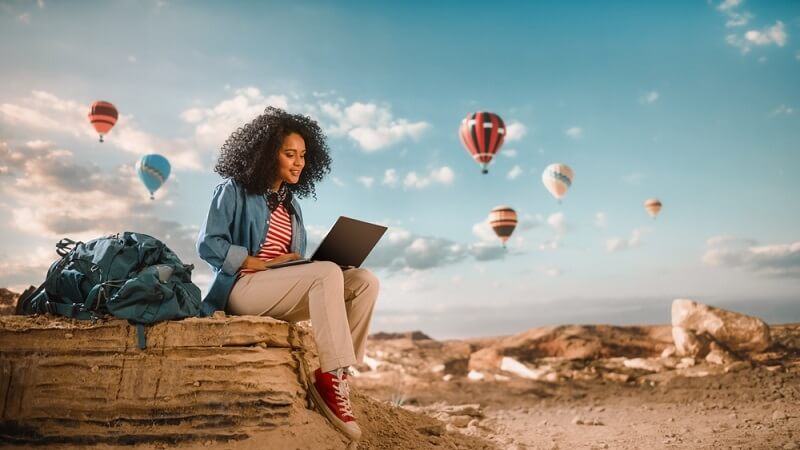With spring break season in full swing, travel brands are likely experiencing an influx of travelers and site visitors. However, consumer travel habits and preferences have evolved drastically in the years since the pandemic began.
Thanks to pop culture and the increasing popularity of social media platforms, travel decisions are being driven by individual interests and obsessions more than ever. As culture shifts, travel brands may be missing the mark if they haven’t evolved and diversified their marketing visuals to match consumer desires.
Personalization and authenticity are key
As travelers focus more on personalized experiences, they want to see themselves reflected in travel imagery. Travelers are becoming increasingly diverse, and modern family structures have taken on many different dynamics. Because of this, capturing a range of identities is intrinsic to authentic representation.
Despite improvements, the top travel industry visuals still reflect some stereotypes, with white people continuing to be featured in outdoor pursuits up to 10x more than other races/ethnicities and LGBTQ+ travelers still largely being defined by their identity.
Travelers are also seeking experiences that allow them to embrace new cultures and people in genuine ways. Having lived their entire lives immersed in technology, younger generations in particular are interested in travel experiences that remind them of the pre-digital era.
According to iStock VisualGPS research 3 in 5 millennials/Gen Zers say cultural experiences are even more important to them now than before the pandemic. Travelers are shredding their bucket lists and putting purpose-driven travel first. Instead of visiting so-called dream destinations and must-see monuments designated by others, they’re choosing places where they can immerse themselves in cultural and educational activities that mean something to them personally.
This shift towards more authentic experiences is especially good news for SMBs. In the era of “no-normal”, travel brands can skip flashy spokespeople and big production budgets and instead focus on real portrayals of cultures and experiences. Brands should be extra conscious of consistency in visual representation and ensure that indigenous people and traditions are portrayed thoughtfully.
Consumers value travel differently
Pandemic revenge travel is real. Widespread Covid-related restrictions made people appreciate travel all that much more when restrictions were lifted. However, ongoing economic instability has complicated things. While 7 in 10 travelers want to maximize their budget, half will spend more indulgently to make up for lost time during Covid, according to iStock’s VisualGPS data. This means that while many consumers are looking for value, they’re also more likely to splurge when the urge strikes.
The importance of mental wellbeing has also changed how consumers value travel. The sudden onset of Covid brought many to a breaking point, as families struggled to balance childcare and work, with minimal social interaction. For perhaps the first time ever, the importance of mental health was recognized widely across society. As a result, once travel was possible again, wellbeing became a major component of it.
In fact, 42% of travelers identified that they’re eager to go on a “health hiatus” to focus on mental or transformative health this year. Despite this, brands are not prioritizing wellness in line with consumer desires. iStock and Getty Images searches for wellness related visuals were down significantly in 2022 compared to 2021.
The line between business and leisure has blurred
With many employees working remotely or in a hybrid environment, travel is no longer defined as exclusively for business or leisure; it’s now often both. Referred to as ‘bleisure travel’, many professionals are now booking longer vacations with time for remote work built in.
‘Bleisure travel’ is likely here to stay; a survey of global travelers by the American Hotel & Lodging Association found that 89% of respondents wanted to add some leisure time to their next business trip. And, it seems brands are taking notice of this shift. According to iStock’s VisualGPS data, the most-used business travel visuals used to focus on transit, however, they now focus on relaxation.
Revamping visual assets
Given the trends shaping the next era of travel, how can small businesses ensure that their assets reflect the needs of travelers now?
Here are the questions brands should be asking themselves:
- Are we making travel personal and authentic?
- Are we showcasing the diversity of today’s travelers, across backgrounds, incomes, interests and cultures?
- Are we avoiding stereotypes while depicting underrepresented travelers?
- Are we representing mental health and wellbeing as an important facet of travel?
- Are we reflecting realistic work/leisure balance through travel visuals?
The pandemic shifted the way consumers travel and their ideologies around its benefits. At the same time, the first digital-native generation is maturing and demanding more personalization and authentic representation from brands and influencers.
SMBs are well-positioned to meet travelers where they are, through showcasing an informed visual persona that reflects the desires of consumers’ modern lives in the era of “no-normal”.
Dr. Rebecca Swift is the VP, Global Head of Creative Insights at iStock and Getty Images.
Diversity stock image by Gorodenkoff/Shutterstock

